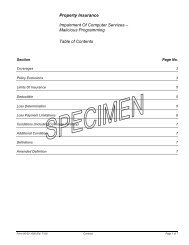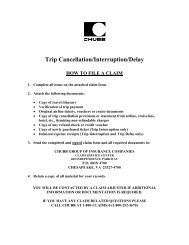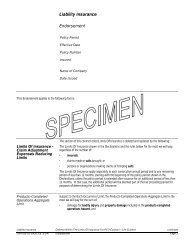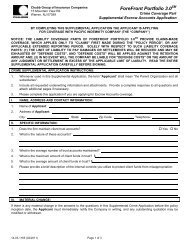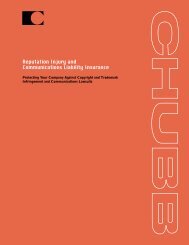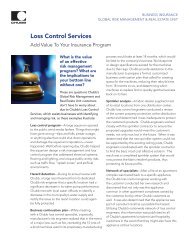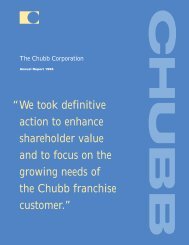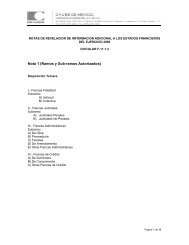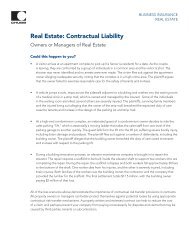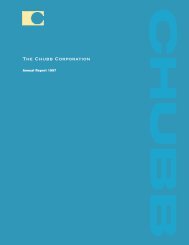Annual Report 2005 - Chubb Group of Insurance Companies
Annual Report 2005 - Chubb Group of Insurance Companies
Annual Report 2005 - Chubb Group of Insurance Companies
You also want an ePaper? Increase the reach of your titles
YUMPU automatically turns print PDFs into web optimized ePapers that Google loves.
theory, insurance coverage is deemed to be triggered from the time a claimant is Ñrst exposed to<br />
asbestos until the manifestation <strong>of</strong> any disease. This interpretation <strong>of</strong> a policy trigger can involve<br />
insurance companies over many years and increases their exposure to liability.<br />
New asbestos claims and new exposures on existing claims have continued unabated despite the<br />
fact that usage <strong>of</strong> asbestos has declined since the mid-1970's. Each claim Ñling typically names dozens<br />
<strong>of</strong> defendants to ensure that there is a solvent company left in the group to eventually pay claims. The<br />
plaintiÅs' bar continues to solicit new claimants through extensive advertising and through asbestos<br />
medical screenings. New asbestos cases are <strong>of</strong>ten Ñled in those jurisdictions with a reputation for<br />
judges and juries that are extremely sympathetic to plaintiÅs. A vast majority <strong>of</strong> asbestos bodily injury<br />
claims are Ñled by claimants who do not show any signs <strong>of</strong> asbestos related disease.<br />
There have been several recent positive events in the asbestos environment:<br />
‚Various challenges to mass screening claimants have been mounted, including a June <strong>2005</strong><br />
U.S. District Court decision in Texas that accused plaintiÅs' lawyers <strong>of</strong> Ñling claims for people<br />
who had not been properly diagnosed with silicosis. Among the repercussions <strong>of</strong> that ruling,<br />
several asbestos injury settlement trusts have refused new claims that were based on the<br />
diagnosis <strong>of</strong> physicians or screening companies named in the case. Further investigations <strong>of</strong> the<br />
medical screening process for asbestos claims are underway.<br />
‚Anumber <strong>of</strong> key jurisdictions have adopted venue reform that requires plaintiÅs to have a<br />
connection to the jurisdiction in order to Ñle a complaint.<br />
‚Since 2004, several states have enacted laws that set medical criteria that must be met for<br />
plaintiÅs to proceed with their claims. Other states have medical criteria bills pending. While<br />
this legislation is being challenged in certain <strong>of</strong> these states, it appears that these laws are<br />
already impacting the Ñling <strong>of</strong> claims by unimpaired plaintiÅs. A related positive development<br />
has been the implementation by several states <strong>of</strong> inactive dockets, which preserve the rights <strong>of</strong><br />
unimpaired claimants but do not provide for payments to these claimants unless they meet<br />
medical criteria.<br />
To date, approximately 75 manufacturers and distributors <strong>of</strong> asbestos products have Ñled for<br />
bankruptcy protection as a result <strong>of</strong> asbestos related liabilities. Certain <strong>of</strong> these manufacturers and<br />
distributors have utilized a practice referred to as a prepackaged bankruptcy, which involves an<br />
agreement to a plan between the debtor and its creditors, including current and future asbestos<br />
claimants. Although the debtor is negotiating in part with its insurers' money, insurers are generally<br />
given only limited opportunity to be heard. In recognition that many aspects <strong>of</strong> prepackaged<br />
bankruptcy plans are unfair to certain classes <strong>of</strong> claimants and to the insurance industry, these plans<br />
are beginning to be closely scrutinized by the courts and rejected when appropriate.<br />
Our most significant individual asbestos exposures involve products liability on the part <strong>of</strong> ""traditional''<br />
defendants who were engaged in the manufacture, distribution or installation <strong>of</strong> asbestos products. We wrote<br />
excess liability and/or general liability coverages for these insureds. While these insureds are relatively few in<br />
number, their exposure has increased in recent years due to the increased volume <strong>of</strong> claims, the erosion <strong>of</strong><br />
much <strong>of</strong> the underlying limits and the bankruptcies <strong>of</strong> target defendants.<br />
Our other asbestos exposures involve products and non-products liability on the part <strong>of</strong> ""peripheral''<br />
defendants, including a mix <strong>of</strong> manufacturers, distributors and installers <strong>of</strong> certain products that contain<br />
asbestos in small quantities and owners or operators <strong>of</strong> properties where asbestos was present. Generally,<br />
these insureds are named defendants on a regional rather than a nationwide basis. As the financial<br />
resources <strong>of</strong> traditional asbestos defendants have been depleted, plaintiffs are targeting these viable<br />
peripheral parties with greater frequency and, in many cases, for larger awards.<br />
Asbestos claims against the major manufacturers, distributors or installers <strong>of</strong> asbestos products<br />
were presented under the products liability section <strong>of</strong> primary general liability policies as well as<br />
under excess liability policies, both <strong>of</strong> which typically had aggregate limits that capped an insurer's<br />
exposure. In recent years, a number <strong>of</strong> asbestos claims by insureds are being presented as ""nonproducts''<br />
claims, such as those by installers <strong>of</strong> asbestos products and by property owners or operators<br />
42



